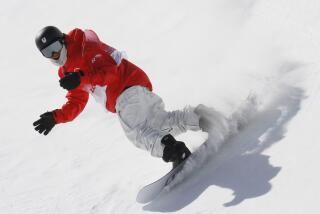Cold Comfort at a Chinese Winter Festival
- Share via
HARBIN, China — So what if the sun sets at 4 p.m.?
All the better to see the Statue of Liberty, the Great Wall and other wonders reproduced in psychedelically lighted ice at the Harbin Ice Lantern Festival in China’s remote, frigid northeast.
These are no banquet-table ice swans. Made of blocks chain-sawed from the frozen Songhua River, copies of the U.S. Capitol, an onion-domed Russian church and other sights stand up to 40 feet tall and fill a city square. Neon tubes of purple, pink, blue and green glow inside.
The January-to-March festival is the centerpiece of winter activities that have turned Harbin, renowned as one of the coldest places in China, into a tourist attraction.
Vacationing in Harbin, capital of Heilongjiang Province across the Russian border from Siberia, is not for the faint of heart. In winter, it’s rarely above 5 degrees. After the last rays of the seven daylight hours fade, temperatures can fall to 20 below zero, and that doesn’t include windchill. The airport even has changing rooms to suit up in snow gear before plunging into the cold.
But for visitors swaddled in parkas and sweaters that make walking a chore, this city where Chinese, Russian and Korean cultural influences overlap offers a unique combination of winter delights.
Most famous is the Ice Lantern Festival. Sculpted ice lanterns are a 300-year-old Manchurian tradition. They once were lighted by candles. The modern version, with neon lights and scenes ranging from London’s Big Ben to the ancient terra cotta warriors of the Chinese Emperor Qin, draws thousands of Chinese and foreign tourists.
Between visits to Russian churches, sleigh rides on the Songhua and dinner at a Korean restaurant, visitors can watch daring locals take a brief, bracing swim in holes chopped through the river ice.
At the Harbin Snow Sculpture Contest, competitors with knives and saws carve 7-foot-high blocks of snow into animals, mythical figures and copies of artworks. Spectators pay to stand shivering on a frozen lake, watching teams of sculptors who have come from as far away as Britain, Malaysia and the United States.
“They invited us. They’re eager to have Americans participate,” said Eric Olsen of Portland, Ore., a member of a four-man U.S. team carving a scene of a Viking surrounded by trees.
On Sun Island, north of Harbin, the Siberian Tiger Park has about two dozen of the world’s 500 remaining Siberian, or Manchurian, tigers--thick-necked, muscular versions of their Bengal cousins.
Buses carry visitors into a grassy enclosure of a few acres surrounded by a fence 15 feet tall. The buses toot their horns to rouse the big cats from where they nap on the frozen ground, breathing steam in the chilly air.
Visitors can pay to have meat thrown to the tigers, who are able to swallow a slab of beef the size of an airline pillow in a single bite. Prices range from 40 yuan ($5) for beef or a live chicken to 5,000 yuan ($600) for a deer.
A more somber stop is a museum on the horrors of wartime Japanese biological weapons research. The 731st Division of the Japanese Imperial Army killed Chinese, Soviet and other captives in germ-warfare tests at its base on the outskirts of Harbin. The two-room museum has documents, photographs and dioramas depicting the mistreatment of prisoners.
In Harbin, the Russian imprint is everywhere, from the domes of St. Sophia’s Church to restaurants where tea is served Russian style, in glasses. Churches, banks and “gingerbread” houses built by refugees from the Russian Revolution of 1917 have given the city the name Little Moscow.
The Russian presence stretches back to 1896, when the czarist government built a railroad through Harbin. After World War II, the city was a center for Soviet-style heavy industry.
Russian buildings from the 1920s have been restored and repainted in their original pastels, giving the city center an antique, Eastern European air--and making Harbin one of the few places in China where urban renewal has meant capitalizing on classic architecture instead of bulldozing it.
More to Read
Sign up for The Wild
We’ll help you find the best places to hike, bike and run, as well as the perfect silent spots for meditation and yoga.
You may occasionally receive promotional content from the Los Angeles Times.




